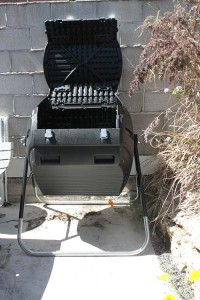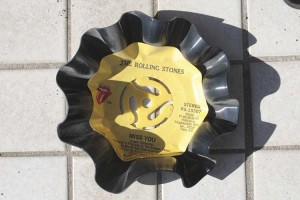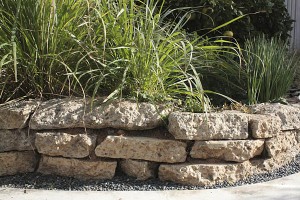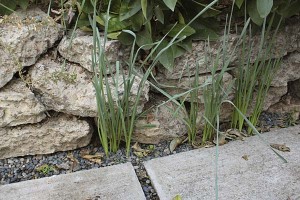I often get the impression that to get your ticket punched as a real, serious gardener you have to take up composting. Still, I gave up on polishing my halo a dozen years ago. The old-fashioned compost pile I had took way more maintenance than I was interested in…all the hassles, especially keeping the beast stirred and watered.
Since those days tumbling composters have really come into their own as an alternative to the piles that just sit there like Uncle Ervin on his Barca-Lounger in front of the TV. The promise of a compost device that simplifies keeping the mix stirred and aerated sounded almost too god to be true, but I’ve been tempted to give them a twirl.
 The opportunity came up as I headed to the back aisles at Costco to pick up some cheese and bread. On my way to the back of the store a big tumbling composter tried to reel me in with its dark tractor beam.
The opportunity came up as I headed to the back aisles at Costco to pick up some cheese and bread. On my way to the back of the store a big tumbling composter tried to reel me in with its dark tractor beam.
The thing with this store is that you usually have your choice of the one item they offer for sale, which in this case was the 80-gallon Lifetime model 60021 tumbling composter. (Costco offers several other models online.) Even with a price tag less than $100 I resisted at first. But I went home and did a little research online. Judging by the customer reviews people generally seemed to like this model, with the main complaint being being about an internal aerating tube that kept getting bent because it was made out of PVC. It seemed like a valid but relatively minor concern, so I decided to give the composter a try.

When you buy this model, you’re really buying a composter kit, not an assembled composter. I documented the time I started, before I opened the box, before I assembled the necessary tools (which ended up requiring–among other things–an electric drill and socket wrenches), before I read the instructions that recommended that it would take two adults to assemble it. John is still hobbling around on crutches right now, so I decided to go it alone.


From the documented end time you can see that it took me about an hour and fifty minutes to put it together. That includes time spent taking a few pieces apart after I’d installed them incorrectly, as well as a few minutes when John came out to supervise my work and ogle the new toy. I’m generally pretty handy with mechanical things, if a little impatient to read all the way through instructions. I also did okay hefting the big 65 pound box the kit came in, and had the added benefit of a power screwdriver. Adjust your expectations for assembly time and effort accordingly.


Things fit together easily and made for a sturdy, double-walled, insulating composting chamber. Apparently the company read the customer complaints about the PVC aerating tube, because by the time they made my version of the model, the flimsy internal part had been replaced with a rigid piece of perforated metal pipe.

The composter now lives outside the kitchen, alongside the trashcans and recycle barrels. It shouldn’t be hard to keep the compost barrel fed and tumbled. Once the barrel is filled it’ll need a few weeks for the compost to cook to perfection, a time when you shouldn’t be feeding it more clippings and scraps. To do things right, having a second barrel at the ready for those times would be the way to go. Within a few weeks I should have a better idea whether this model of composter lives up to my expectations and warrants my buying a second one.
So, will I become a real, serious, composting gardener? I’d say it’s off to a good start.












